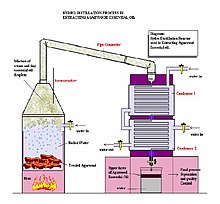Herbal distillate

Herbal distillates, also known as floral waters, hydrosols, hydrolates, herbal waters, and essential waters, are aqueous products of
Production
Herbal distillates are produced in the same or similar manner as essential oils. However, essential oils will float to the top of the distillate where it can be removed, leaving behind the watery distillate. For this reason, the term essential water is an apt description. In the past, these essential waters were often considered a byproduct of distillation, but are now considered an important co-product.[7] The produced herbal waters are essentially diluted essential oils at less than 1% concentration (typically 0.02% to 0.05%).[8] Several factors, such as temperature and a herb's growth cycle, impact the characteristics of a distillate, and therefore influence the timing of the distillation. Rosemary, for example, should be distilled in the peak of summer before it flowers.[9]
Usage
This section needs expansion. You can help by adding to it. (December 2017) |
Distillates are used as flavorings, cosmetics and as
Science
The science of distillation is based on the fact that different substances vaporise at different temperatures. Unlike other extraction techniques based on solubility of a compound in either water or oil, distillation will separate components regardless of their solubility. The distillate will contain compounds that vaporize at or below the temperature of distillation. The actual chemical components of these orange herbal distillates have not yet been fully identified, but plant distillates will usually contain essential oil compounds as well as organic acids and other water-soluble plant components. Compounds with a higher vaporization point will remain behind and will include many of the water-soluble plant pigments and flavonoids.[10]
Because hydrosols are produced at high temperatures and are somewhat acidic, they tend to inhibit bacterial growth but not fungal growth. They are not sterile, and should be kept refrigerated to preserve freshness.[11] Herbal distillates degrade over time and will degrade faster than essential oils, which are more stable.[12] Small-scale producers of hydrosols must be particularly aware of the risk of bacterial contamination and take steps to prevent it. Despite concerns that there may be significant amounts of heavy metals in popular herbal distillates, this has not shown to be the case.[13]
See also
- Orange flower water
- Rose water
- Witch hazel (astringent)
References
- ^ "This Natural Skin Care Ingredient Might Be More Effective Than You Thought". HuffPost. 2023-06-13. Retrieved 2024-04-12.
- ^ "Pretty, Please: Mindful Skin Care, an Artist Reconsidered, and Bright Eyes for Spring". Vanity Fair. 2023-05-01. Retrieved 2024-04-12.
- ^ López, Quispe. "A dermatologist told me everything I'm doing wrong in my skincare routine and how to know if a product is worth it". Business Insider. Retrieved 2024-04-12.
- PMID 34945695.
- PMID 31080888.
- PMID 32751488.
- PMID 29398017.
- ^ National Association for Holistic Aromatherapy. What are Hydrosols. Accessed 12-5-13
- ^ a b Mulvaney, Jill (September 2012). "Traditional hydrosols and hydro-distillation". Australian Journal of Herbal Medicine. 24: 101–103.
- PMID 18476875.
- ^ Cindy Jones. "Herbal Waters or Distillates (Hydrosols)". Sagescript Institute. Archived from the original on 2006-10-28. Retrieved 2006-10-23.
- ^ Garneau, François-Xavier; Collin, Guy; Gagnon, Hélène (June 2014). "Chemical composition and stability of hydrosols obtained during essential oil production. II. The case of Picea glauca (Moench) Voss., Solidago puberula Nutt., and Mentha piperita" (PDF). American Journal of Essential Oils and Natural Products. 1: 29–35.
- PMID 27274526.
Books
- Firth, Grace. Secrets of the Still. Epm Pubns Inc; First edition (June 1983)
- Price, Len and Price, Shirley. Understanding Hydrolats: The Specific Hydrosols for Aromatherapy: A Guide for Health Professional. Churchill Livingstone 2004
- Rose, Jeanne. 375 Essential Oils & Hydrosols. Frog, Ltd, Berkeley, CA, 1999. ISBN 1-883319-89-7
- Rose, Jeanne. Hydrosols & Aromatic Waters. Institute of Aromatic & Herbal Study, 2007.
